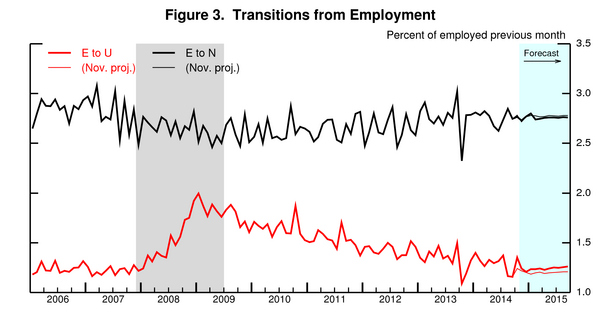This post discusses my monthly update of the Barnichon-Nekarda model. For an introduction to the basic concepts used in this post, read my introductory post (Full details are available here.)
In November, the unemployment rate remained steady at 5.8%, as anticipated by the model. Going forward, the contour of the forecast is broadly unchanged with a slow decline in unemployment over the next 6 months. I anticipate the unemployment rate to remain steady in December and to reach 5.6% by June 2015

This model’s forecast can be easily understood by looking at the projected behavior of the “steady-state” unemployment rate. The steady-state unemployment rate, the rate of unemployment implied by the underlying labor force flows—the blue line in figure 2— stands currently at 5.5%, 0.3% lower than the actual unemployment rate. Our research shows that the actual unemployment rate converges toward this steady state. With a steady-state unemployment rate substantially lower than the actual rate, this “steady-state convergence dynamic” will push the unemployment rate down, implying a decline in unemployment going forward.

To forecast the behavior of steady-state unemployment, the model propagates forward its best estimate for how the flows in and out of unemployment will evolve over time. The two most important flows –workers’ job finding rate (UE) and workers job separation rate (EU)—have been behaving slightly less well than predicted by the model (figure 3 and 4), and in consequence, their forecasts have been revised slightly downward. This revision explains the slightly less upbeat forecast this month compared to last month.



To read more about the underlying model and the evidence that it outperforms other unemployment rate forecasts, see Barnichon and Nekarda (2012).



Commentary
Unemployment Steady in December, Then Slow Decline Over the Next 6 Months
January 7, 2015